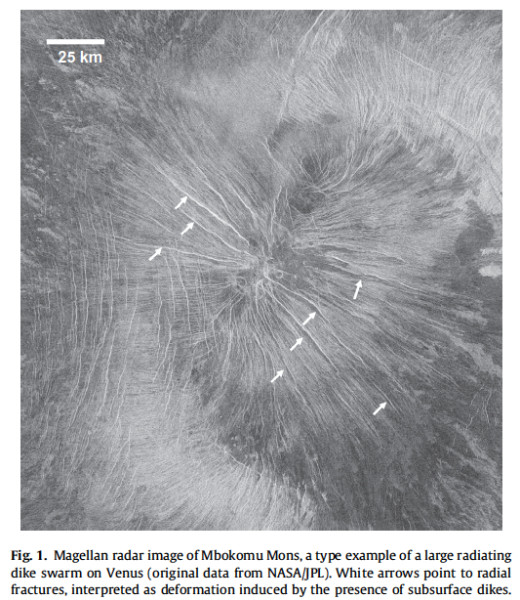 Giant radial dike systems that on average are several hundred kilometers in radius can be found on Earth, Venus and Mars. To date, however, it has been unclear how these impressive volcanic features might originate. For such systems to form, massive quantities of magma ascending from the mantle must encounter both a stress field that favors a radial dike configuration and something that redirects ascending magma laterally at shallow depths within the lithosphere. The former condition is straightforward to create via large-scale flexural uplift in response to plume impingement, underplating, or a similar mechanism; however, the stress state resulting from this process strongly favors continued ascent and eruption, inconsistent with evidence of long-distance lateral transport of magma through the radial dikes.
Giant radial dike systems that on average are several hundred kilometers in radius can be found on Earth, Venus and Mars. To date, however, it has been unclear how these impressive volcanic features might originate. For such systems to form, massive quantities of magma ascending from the mantle must encounter both a stress field that favors a radial dike configuration and something that redirects ascending magma laterally at shallow depths within the lithosphere. The former condition is straightforward to create via large-scale flexural uplift in response to plume impingement, underplating, or a similar mechanism; however, the stress state resulting from this process strongly favors continued ascent and eruption, inconsistent with evidence of long-distance lateral transport of magma through the radial dikes.
In a paper recently published in the journal Icarus, Dr. Gerald Galgana, Dr. Patrick McGovern (colleagues from the Lunar and Planetary Institute in Houston, TX) and I have demonstrated that initial eruptions related to flexural uplift can produce a surface load (e.g., a large volcanic edifice) that acts to counter the uplift, suppressing upward flexure and simultaneously creating a stress cap of sufficient magnitude that lateral redirection of magma into radial dike systems becomes likely. This exciting new understanding links mechanical processes acting upon the lithosphere directly to the volcanological outcomes, improving our insight into the formation and evolution of some of the largest magmatic systems and radial dike swarms identified on multiple planets.
For more information: Galgana, G.A., E.B. Grosfils and P.J. McGovern, 2013. Radial dike formation on Venus: Insights from models of uplift, flexure and magmatism. Icarus, 225, 538-547.